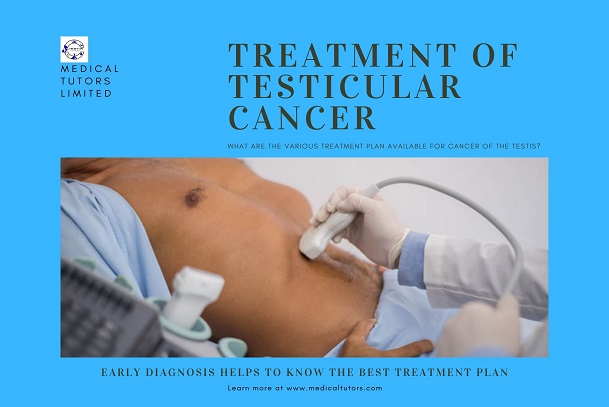 Wash your hands regularly and wear a face mask.
Learn more
Wash your hands regularly and wear a face mask.
Learn more

Introduction
Treating testicular cancer is very possible especially when they are discovered at its earliest stages, making it possible for people who have been diagnosed with testicular cancer live for at least another 5 years after diagnosis.
Just like other type of cancer, testicular cancer is usually treated different by a team of different doctors and health care professionals such as oncologists, urologists, nurses, social worker etc., who together create the best treatment plan for each patient considering the patient’s diagnosis and general health.
Also, other factors considered during treatment for testicular cancer are the side effects associated with each treatment method; type and stages of testicular cancer.
Treatment of testicular cancer usually involve one or the combination of the following:
Surgery
This is the main treatment method used for testicular cancer. This involves the removal of the tumor, surrounding healthy tissues. For testicular cancer, one or both testicles are usually removed to prevent the tumor from spreading.
The major side effect from surgery is fertility. When one testicle is removed, it does not usually affect the person’s sex life or fertility, but the removal of both testicles may not allow the male to conceive naturally. The removal of the testicle is referred to as Orchiectomy.
Other side effects from the removal of testicles may include:
Surgery can be used in all stages of testicular cancers, including non-seminoma and seminoma testicular cancers.
Radiation Therapy
Radiation therapy is the use of high energy beams to destroy cancer cells in the body. It damages the DNA inside the tumor cells, destroying the ability of the cancer cells to reproduce, removing and preventing it from spreading. It is usually used for seminoma cell cancers because most non-seminomas are usually resistant to radiation therapy.
Radiation therapy can also be given as an option if testicular cancer might have spread to a distant organ such as the brain.
The side effects of radiation therapy are usually temporary, and includes:
Chemotherapy
This is the use of medications (drug) to destroy cancer cells, preventing it from growing or spreading to other organs of the body.
For testicular cancer, chemotherapy is usually used when the cancer cells have spread beyond the testicles, or probably when the serum tumor markers increase after surgery have been performed. Medications used during chemotherapy for testicular cancer is injected into a vein so that it can enter the bloodstream and reaches cancer cell throughout the body. It is very helpful in reducing the recurrence of testicular cancer.
Although targeted at cancerous cells, chemotherapy can also attack healthy cells which may lead to the following side effects:
Surveillance
This is when medical checkups are performed by medical doctors on patient after testicular cancer treatment has been completed. This helps to know and check for signs if testicular cancer has re-occurred.
Surveillance do not usually involve any form of treatment, but involves normal regular check-ups, physical examinations, tumor marker tests, and imaging tests.
During surveillance, if there are signs of cancer growth or re-occurrence, or probably hormone level changes (especially if the hormone is low), then more treatment plans would be offered, but if there exists none, then only surveillance is needed.
NOTE: All side effects which occur after each treatment options usually stop once each treatment plan has been completed.
Treatment for Children
Testicular tumors are quite rare in children but they can be found; and if diagnosed early, treatment is always successful. But when these tumors have spread, treating them tends to be more difficult.
For older men, testicular cancer often begins as a painless lump but in boys, yolk sac tumors and teratomas are discovered. Therefore, the cancer-cell types found in boys are:
The most common treatment plan for children includes:
After treatment is completed, most children are observed for at least two (2) years with different physical examinations, tumor markers and imaging tests. Most boys treated for testicular cancer usually end up healthy, and can have children when they grow up.
References: American Cancer Society; WHO; WebMD, Cancer.net
© Medical Tutors Limited